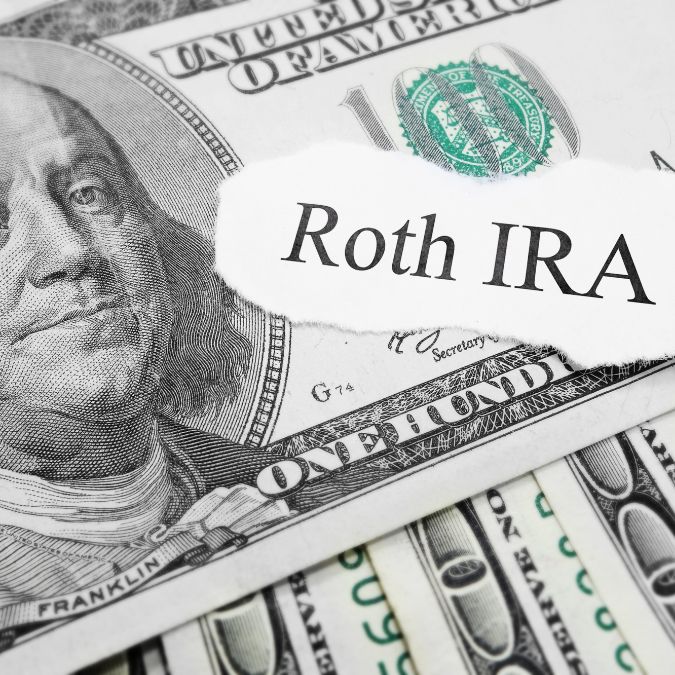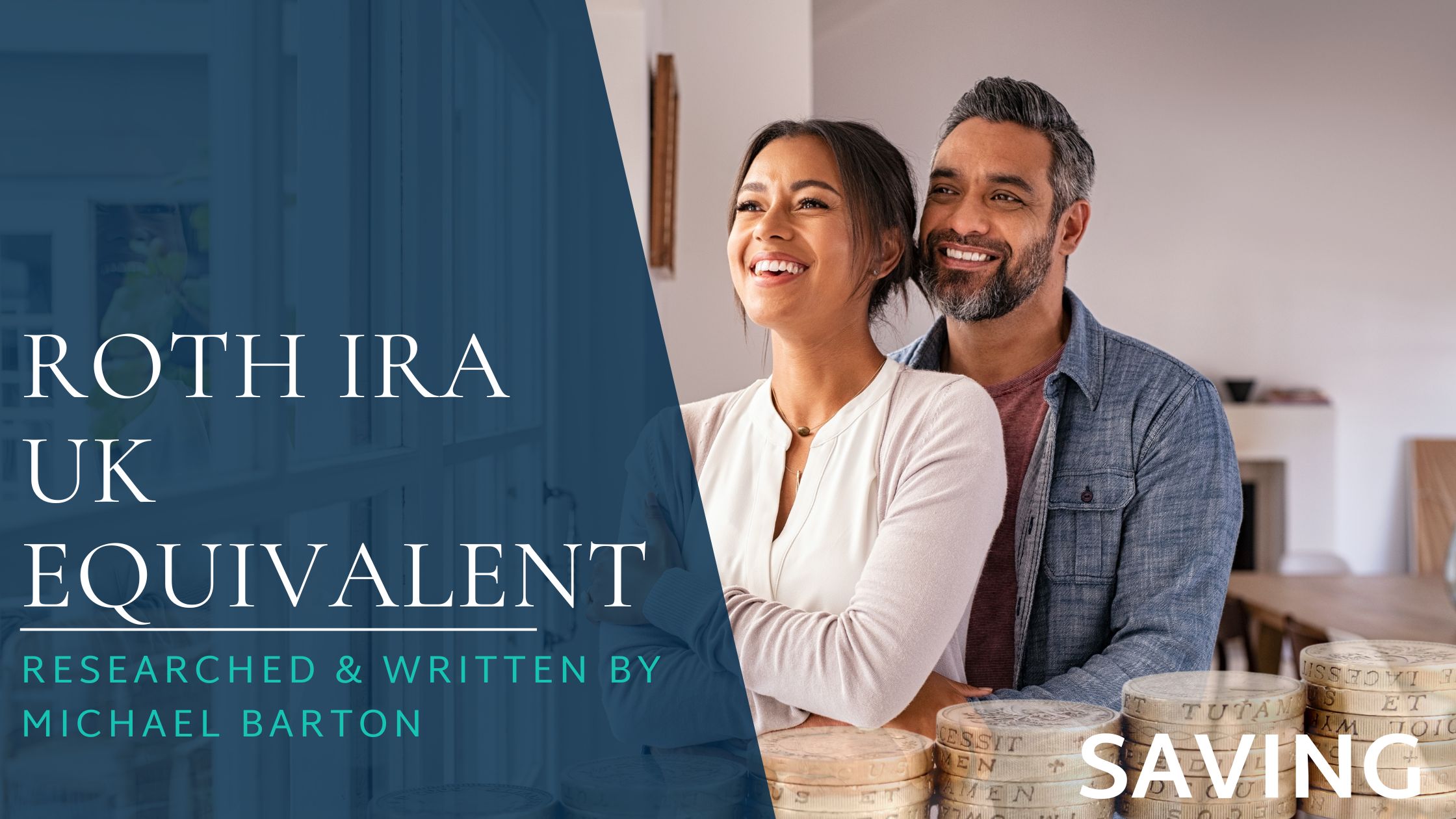Want a Roth IRA but don’t live in the US? The UK has its own alternatives to help you save for your first home or retirement. Here we seek out the best Roth IRA UK equivalent for you.
I’ve worked a lot with American firms and individuals, and an investment product that is spoken about often is the Roth IRA. It’s a great retirement account, but we don’t have the same in the UK.
However, we do have a lookalike: the Individual Savings Account (ISA).
In this article, I look at the similarities and differences between an ISA and a Roth IRA.
30-Second Summary
Are you looking for a Roth IRA in the UK?
While there isn’t an exact match, there are some great options available to you.
First, a stocks and shares ISA is a close cousin, as close to a Roth IRA UK equivalent as you’ll find. It’s flexible, tax efficient, and there is no limit on the age for withdrawals – and withdrawals are tax free.
If you need a product focused on saving for retirement, then a SIPP could be your hero product. You can contribute up to £60k in any tax year with full tax relief on those contributions. You can’t make withdrawals before the age of 55 (rising to 57 from 2028), but when you do, you can take 25% as a tax-free cash lump sum.
As a halfway house, if you’re under 40 and aiming for a home or retirement, the Lifetime ISA (LISA) could be your golden ticket. You can contribute up to £4,000 per year and benefit from a government bonus of 25%. When you withdraw (either to buy a first home or to retire), you won’t pay tax on your withdrawal.
*Capital at risk
What’s a Roth IRA?

An IRA (Individual Retirement Account) is a way of investing tax efficiently towards retirement in the United States. Providing you withdraw money under what is called a ‘qualified withdrawal’, any growth is not taxed.
One of the biggest advantages of the Roth IRA is that you can withdraw money from it from the age of 59½ without paying income tax – providing you opened the account at least five years previously.
If you take money out before you reach 59½, you will usually be taxed and required to pay penalties.
You can contribute up to $6,500 per year, depending on your income. This rises to $7,500 a year once you are 50.
The more you earn, the less you can contribute. If you earn more than $153,000 as a single person or $228,000 as a couple (rising to $161,000 and $240,000 respectively for the tax year 2024), you cannot contribute to a Roth IRA.
While growth in the fund and qualified withdrawals are tax free, you don’t get tax relief on what you pay in – contributions are made after tax. If you are eligible to invest, there is no minimum investment requirement, only a maximum amount as described above.
Another feature of Roth IRAs is that, unlike other retirement accounts – such as the 401(k) – you don’t have to take income from them. You can leave your funds to grow.
Overall, very flexible, functional, and adaptable.
Quick Comparisons
Here’s a handy table I’ve put together so that you can see clear comparisons between the US’s Roth IRA and our Stocks and Shares ISA, Lifetime ISA, and a SIPP:
| Feature | Roth IRA (USA) | Stocks and Shares ISA (UK) | Lifetime ISA (UK) | SIPP (UK) |
| Eligibility | US residents | UK residents over 18 | UK residents 18-40 to open | UK residents over 18 |
| Contribution Limits (per year) | Up to $6,500 or $7,500 if 50+ | Up to £20,000 | Up to £4,000 | Up to £40,000 or 100% of earnings |
| Withdrawal Age | 59½ (5 years after opening) | Any time (varies by ISA type) | For retirement from age 60 | From age 55 (57 by 2028) |
| Tax Benefits | Tax-free growth; no tax on qualified withdrawals | Investments grow tax free; withdrawals are tax free | Tax-free growth; 25% government bonus; tax-free withdrawals for retirement or first home | Tax-free growth; 25% tax-free lump sum on withdrawal. Above this, withdrawals are tax liable. |
| Contribution Tax Relief | None (contributions made after tax) | None (contributions made after tax) | 25% government bonus on contributions, to a maximum bonus of £1,000 in a single tax year | Full tax relief on contributions within the contribution limits |
| Investment Options | Wide range (no specifics in article) | Depends on provider (stocks, shares, funds, etc.) | As per the Stocks and Shares ISA | Wide range of investment assets and securities |
| Minimum Investment | No minimum requirement | Varies by provider | Varies by provider | Varies by provider |
| Purpose | Retirement saving | Flexible (can be used for any purpose) | Retirement or first home purchase | Retirement saving |
| Penalties | Tax and penalties for early withdrawal | None (though may depend upon provider) | Penalties for non-qualified withdrawals (exceptions for illness) | Penalties for exceeding maximum contributions and withdrawals made outside SIPP rules |
Can a UK Resident Invest in a Roth IRA?
Unfortunately, you can’t. It’s a product that is solely available in the United States for US taxpayers saving toward retirement.
What we have in the UK are workplace pensions, personal pensions, and SIPPs. (Hey, don’t knock them, these are great products for investing for retirement – and we’ll look at SIPPs in a few moments.)
However, there is another alternative that shares many similar features to a Roth ISA.
The UK’s Closest Roth IRA Equivalent: the ISA
Though we don’t have an exact copy of the Roth IRA, we do have a product that is close: the stocks and shares Individual Savings Account (ISA).
Like the Roth IRA:
- Contributions are made after tax
- Investments within the ISA grow tax free
- Withdrawals are made tax free
- How much you can contribute is limited
- There is no lower limit to the contributions you can make
Unlike the Roth IRA:
- While the maximum contribution amount is limited, it is not dependent upon your earnings
- You can withdraw money at any time, without penalties or a tax liability
This last point is important. Unlike a Roth IRA that is specifically set up for retirement investing, a stocks and shares ISA can be used for any purpose, which makes it even more flexible and adaptable than a Roth IRA.
*Capital at risk
How Does an ISA Work?

You can invest in an ISA by opening an ISA account with a financial institution, or with an investment platform like Moneyfarm or Hargreaves Lansdown. You might also consider platforms such as Wealthify, Nutmeg, AJ Bell or Vanguard.
The range of investments you can make depends on what the provider allows and gives access to, though most private investors will invest in funds.
It’s worth mentioning here that there are several types of ISAs – Cash ISAs, stocks and shares ISAs, Lifetime ISAs, and Innovative Finance ISAs.
The main rules regarding ISAs are:
- You must be a UK resident and over 18 to open a stocks and shares ISA, though there are specific rules for Junior ISAs and Lifetime ISAs.
- You can invest up to £20,000 in ISAs in any tax year.
- You can split your investment across different ISA types.
- You can withdraw funds at any time (though this depends upon the type of ISA).
- You cannot roll over any unused contribution allowance to the following year.
*Capital at risk
Should You Open a Lifetime ISA?
A Lifetime ISA (also known as a LISA) is like a cross between a Roth IRA, an ISA, and a SIPP. It’s closer to a Roth because it can only be used for two reasons – saving toward your retirement or purchasing your first house.

There are also limits on the ages at which you can invest and withdraw from a LISA.
Crucially – and I love this – it also gives you a little bit of extra tax relief, which gives your money a 25% boost on the amount you invest. Yes, that’s right, the government pays you a bonus on the amount you contribute, and then, providing you don’t break the LISA rules, you get to withdraw funds tax free when you retire!
Here are the key rules for investing in a LISA:
- You must be at least 18 and under 40, and also a UK resident to open a LISA.
- You can contribute up to £4,000 per year.
- Your LISA contribution counts toward your overall ISA allowance.
- For every £4 you contribute, the government will add £1, up to a maximum of £1,000. If you contribute £4,000, you will invest £5,000.
- You must use the proceeds of a LISA to either buy your first home (for example, as part of your deposit) or for retirement (from age 60).
- If using proceeds for a home purchase, you can withdraw at any time.
- If using for retirement, you cannot withdraw tax-free before you reach the age of 60.
- There will be penalties if you break the withdrawal rules, though these may be waived if you have a critical illness/terminal illness.
Free cash from the government? Tax-free growth? No tax to pay when you withdraw funds? If you’re saving toward your first home purchase or retirement, the LISA is a great investment product. Dare I say it, even better than a Roth IRA?
Should You Invest via Retirement Using a SIPP Not an ISA?
If you don’t require the full flexibility of an ISA, and you’ve maxed out your LISA allowance, you might consider investing in a Self-Invested Personal Pension (SIPP).
This is a product designed specifically for investment toward retirement, and has some advantages over an ISA. These include:
- You can contribute up to £60,000 or 100% of your earnings (whichever is lower) in any tax year and receive full tax relief on those contributions (if you pay in more, you’ll be liable to a tax charge).
- You can invest in a wide range of investment assets and securities.
- The fund grows tax free.
- When you take benefits from the SIPP, you can take 25% as a tax-free cash lump sum. Above this amount, withdrawals are liable to tax.
- You can start to withdraw from the SIPP from age 55 (rising to 57 in 2028).
To invest in a SIPP, you’ll need to be a UK resident and over 18. The minimum you’ll need to contribute depends upon the rules of the SIPP provider you select.
Roth IRA Equivalents Unravelled

A Stocks and Shares ISA is like a Roth IRA in its tax treatment of contributions, growth, and withdrawals. There is no age restriction for withdrawing money from this type of ISA, and the maximum annual contributions of £20,000 are much higher than for Roth IRAs.
For a purely retirement-focused product, the SIPP stands out. It allows you to contribute up to £60,000 per year with tax relief on contributions.
Like ISAs, a SIPP benefits from tax-free growth in the fund. You can withdraw funds from the age of 55 (57 from 2028), with the first 25% taken as a tax-free cash lump sum. However, above this, withdrawals will be liable for tax.
The Lifetime ISA (LISA) is akin to a hybrid of an ISA and a SIPP. This could be a great option for you if you are saving toward your first home or retirement. It’s less flexible than an ISA (for example, there are greater restrictions to open and withdraw), but it benefits from tax-free growth and tax-free withdrawals like an ISA.
It also benefits from a government bonus on contributions. You can contribute up to £4,000 per year into a LISA, with a maximum government bonus of £1,000.
In summary, while the Roth ISA is a cornerstone of retirement planning for US citizens, the alternatives available in the UK offer you flexible and tax-efficient options to invest for your unique financial goals throughout life.

